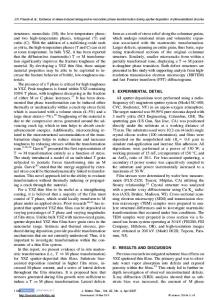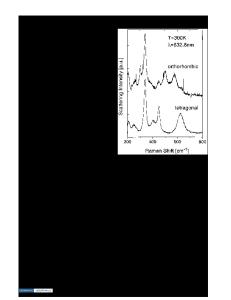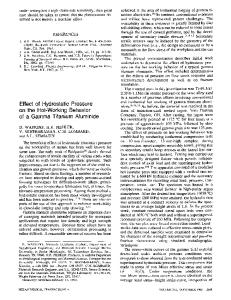Tetragonal to monoclinic phase transition observed during Zr anodisation
- PDF / 434,124 Bytes
- 9 Pages / 595.276 x 790.866 pts Page_size
- 46 Downloads / 263 Views
ORIGINAL PAPER
Tetragonal to monoclinic phase transition observed during Zr anodisation Francisco Trivinho-Strixino & Donizete X. da Silva & Carlos O. Paiva-Santos & Ernesto C. Pereira
Received: 25 September 2011 / Revised: 11 September 2012 / Accepted: 14 September 2012 / Published online: 22 September 2012 # Springer-Verlag Berlin Heidelberg 2012
Abstract Plasma electrolytic oxidation (PEO) is a coating procedure that utilises anodic oxidation in aqueous electrolytes above the dielectric breakdown voltage to produce oxide coatings that have specific properties. These conditions facilitate oxide formation under localised high temperatures and pressures that originate from short-lived microdischarges at sites over the metal surface and have fast oxide volume expansion. Anodic ZrO2 films were prepared by subjecting metallic zirconium to PEO in acid solutions (H2C2O4 and H3PO4) using a galvanostatic DC regime. The ZrO2 microstructure was investigated in films that were prepared at different charge densities. During the anodic breakdown, an important change in the amplitude of the voltage oscillations at a specific charge density was observed (i.e., the transition charge density (QT)). We verified that this transition charge is a monotonic function of both the current density and temperature applied during the anod-
F. Trivinho-Strixino Departamento de Física, Química e Matemática, Universidade Federal de São Carlos, São Carlos, SP, Brazil C. O. Paiva-Santos Laboratório Computacional de Análises Cristalográficas e Cristalinas, Depto de Físico-Química, Instituto de Química, Universidade Estadual Paulista, Araraquara, SP, Brazil E. C. Pereira (*) Departamento de Química, Universidade Federal de São Carlos, Rod. Washington Luis Km 235, Cx 676, São Carlos, SP, Brazil e-mail: [email protected] Present Address: D. X. da Silva Universidade Federal de Tocantins, Palmas, TO, Brazil
isation, which indicated that QT is an intrinsic response of this system. The oxide morphology and microstructure were characterised using SEM and X-ray diffraction experiments (XRD) techniques. X-ray diffraction analysis revealed that the change in voltage oscillation was correlated with oxide microstructure changes during the breakdown process. Keywords Valve metals . ZrO2 . Anodic films . Anodic breakdown . Microstructure . Phase transformation . Plasma electrolytic oxidation (PEO)
Introduction Anodic oxide films on valve metals have been investigated since the 1950s [1–5]. The electronic, electrochemical and optical properties of these materials motivated our study in this area due to the different technological applications and the interesting fundamental aspects of oxide growth for protective coatings. Recently, interest in these materials has increased due to the potential for morphological and composition control on anodic alumina [6–8] and other valve metal oxides [9–14] produced by plasma electrolytic oxidation (PEO). During the oxide growth at the galvanostatic DC regime, the film thickness increases until it reaches a critical val
Data Loading...











